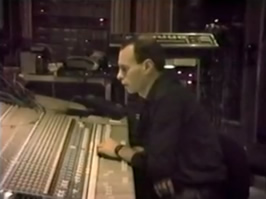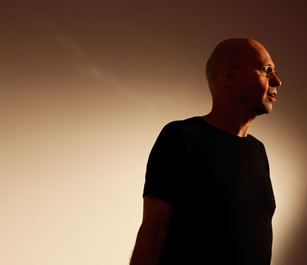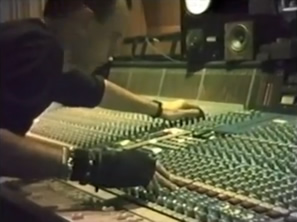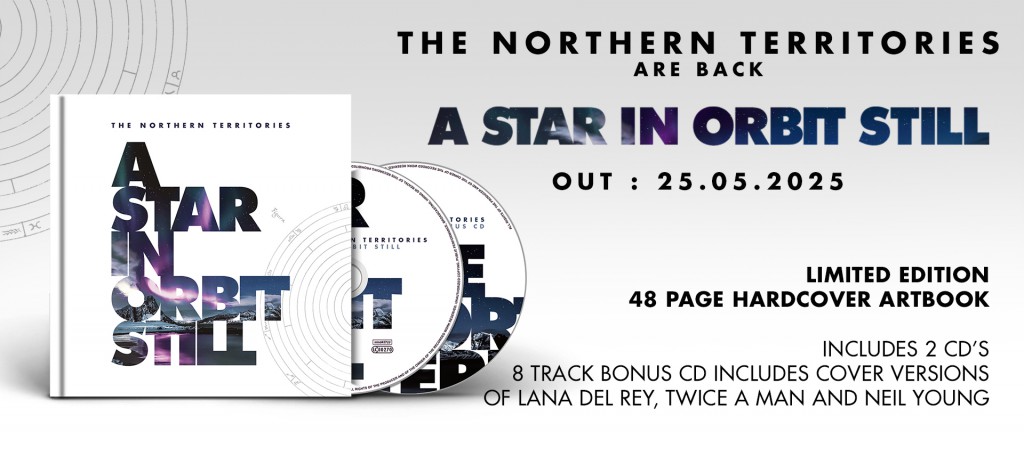
If you are a nitpicker like me and actually enjoy reading the credit and production pages in booklets and press releases and have a genuine interest in electronic music the you will have read the name Gareth Jones several times. If not, you will most definitely have listened to music produced, mixed or engineered by him.
Gareth Jones is an English record producer mixer from London and during the eighties he was involved in making some of the most ground breaking electronic records and worked with artists such as Depeche Mode, Humpe Humpe, Thomas Fehlmann, Einstürzende Neubauten, Wire, Diamanda Galas, Erasure and Nick Cave. He started his music career as a trainee at the BBC, but is mostly self-taught, and was employed at the Pathway studio where he recorded and mixed the album “Metamatic” by John Foxx in 1980. Becoming a Berliner he spent many years as a resident producer at famed Hansa Studio recording and co-producing the Depeche Mode albums “Construction Time Again”, “Some Great Reward” and “Black Celebration”. He has been in the front line in terms of technical development and has made some pioneering work using digital equipment, especially the use of sampling.
Since then has extended his recording CV enormously and is still very busy recording and producing. Lately he has been teaching at the Red Bull Academy in Madrid as well as mixing and producing Polly Scattergood, the new Bunny Lake album and doing some extended remixes for Erasure and S.C.U.M. At the Mute festival in May he gave a talk about his involvement with Mute records and I was given the opportunity to sit down and ask him a few questions after his talk. This is a resume of the interview and the talk and subsequent communication via email.
An inspiration that carried on for 30 years
The cue outside the Roundhouse establishment was growing to the point where the security personnel told some people that it was no point in queuing for a seat in the auditorium where Gareth was to hold his lecture, even though they had VIP-tickets. Being an early bird I managed to get a chair in the front row of the auditorium, which was decorated with a range of rare and huge Mute posters spanning 30 years. Starting by asking the audience about how may who worked in a recording studio led to the talk being shifted more to the fan interest side of Mute rather than explaining technical studio procedures. I then decided to shift my focus for the forthcoming interview towards the technical aspects of the recording of music. Gareth was introduced and started with some history of his involvement with Mute.
- The first time I heard a Mute record was when Daniel Miller released “Warm Leatherette” under the name the Normal. John Foxx and me were working together and he brought a copy of the seven-inch, which blew us away. We found it inspirational and that inspiration carried on for the next 30 years or so. Much later it turned out that Depeche Mode were looking for a studio to record their third album in. That was “Construction Time Again”. That’s how it all started. It was a wonderful experience and still is, working for Mute, because for me it was a great mixture of experimentation and pop music. Everyone tried to do new things and nobody tried to copy anybody else and I felt very comfortable in that environment and very fortunate to be included in a setting were all new ideas were welcome, but not used of course. We worked with big analogue tape machines and mixing desks and that contributed to the sound in a way that we perhaps didn’t realize at the time.
- I was quite proud when I recently read on a website that “Construction Time Again” has the largest dynamic range. One essential thing about my work with Depeche Mode was the use of machines and computers that was becoming affordable making it possible to use technology to realize interesting versions of songs. We used guitar amps and recording synthesizers through them, just like a rock band sort of. It added the feel of the room and was innovative in a way, made the sounds distinct. Alan Wilder asked if Daniel Miller and me would join him in the Hansa studio during his Recoil tour. Both Daniel and me thought it was a great idea and said yes. Later on we thought, what have we done, what should we do. Since the old tapes had already been digitized we got a hard drive and started to sample some of it and pretty soon it took off. It had its own momentum and we made a mash up of it, most of it instrumental.

Live the album
The first Mute record Gareth was allowed to make sort of his own was “Gag” by Fad Gadget.
- It was a wonderful creative experience. We recorded it in the Berlin Hansa studio. The next couple of Depeche Mode records were also recorded in Hansa. We used a lot of sampling; we recorded metal hits and all kind of stuff in the field, for “Pipeline” for instance. That idea got its own life. And the idea got so strong that we didn’t even use mixing effects. The whole thing was recorded with a close field microphone and a distant one with much ambience and reverb and we mixed accordingly for the part that they were used for.
For the third album I worked on with Depeche Mode, “Black Celebration”, Daniel Miller had this crazy idea. Why don’t we live the album this time? We are not going to do anything else then record the album. We did it, we started recording and didn’t leave the studio until it was finished. In the end we went totally nuts, but perhaps that tension and energy is reflected in the record.
Gareth Jones also worked with Einstürzende Neubauten.
- Through them I met Diamanda Galas. She is a very strong and powerful person with great new ideas – and of course a magical voice. Through my work with Diamanda Galas I met Andy Bell of Erasure. That started what was to become a beautiful friendship and creative partnership. I loved Andy’s voice from the very beginning and I always thought he sings naturally, just like a bird, it was a profound moment for me. One thing I learnt from Vince Clarke is the value of modesty. Vince is a very down to earth kind of guy and being around him helped me to know my place in the world, hahaha… It has also made me less attached to my own ideas. I don’t mind bringing five ideas to the table and if all are rejected that is fine. For me it is all about making the song function and work as well as we can. When I met Vince he was using all analogue equipment, and I travelled on a journey with Vince from analogue machines through digital stuff and computers and then back to analogue equipment again, much like I have returned to analogue tapes.
Fighting cancer
In 2008 Gareth was diagnosed with squamous cell carcinoma, which is a form of cancer. He openly and very candidly described his journey with cancer in a blog, which I followed closely. At the time both my parents were fighting cancer and it was nice and positive to read about the daily routine by someone who actually beat this modern plague. Thanking him for writing the blog my first question during the interview is of course:
How are you doing now?
- Very well, thank you very much.
I ask if it is ok the record the interview and he smiles and says yes and asks if it is for transcription purposes, which it is, or for actually broadcasting the recording, because in that case he smilingly suggest changing the angle of the recording mics. I also use a second recording device, which triggers Gareth’s attention.
- Good man, obviously backup is extremely important. My audio drive is backup up every hour in the background.
Like Apple’s Time Machine?
- Actually I use CCC (Carbon Copy Cloner). Sometimes that interferes with the recording process so I turn it off. I will invest in a RAID-system soon. At the end of every day of recording we do off-site backups. I also have a small pocket drive. I am also recording a lot to tape right now, just the final mix. As I record to tape, we listen off the reproduction head and it then goes straight to a 96kHz rig. So the tape gets archived immediately, which I feel is so important since the tape can always break and so on. It is just a two-track tape; I am not working on multitrack tape at the moment. However I’d love to do a multitrack project this year though. I am just looking for the right project to do really.
What are you working on right now, in May?
- I am mixing a record for a new artist called David’s Lyre. I think he is on Hideout Records. It is his first album and he has done a couple of singles before. It is sort of alternative rock music I suppose. He has a wonderful voice and wonderful songs and we are mixing it in an analogue studio in north London.
Which studio is it?
- Snap studio. It has a vintage 1972 broadcast Neve 5316 console. Loads of nice old analogue gear, everything seems to work really well. Fantastic sounding ATC monitors (ATC SCM25 SL Pro), not too big but really translates to my home system. And they also have a lovely half-inch machine. So many of the young people I am working with right now are technically interested in older equipment and really into tape. I grew up with tape so I am having a new love affair with it. I feel very comfortable working with tape, I love what is does. I love the fact that it is physical, it goes round and round. It has beautiful sonic qualities, subtle but lovely. Snap is a really good place with good people.

Embracing technology
How has your recording setup changed throughout the years? Or rather which changes are the most significant ones for your work?
- It has changed massively obviously. When I started mixing and became a little bit successful I had a lot of racks of outboard equipment. Now I tend to think that if I am using a studio, the studio is going to supply the equipment and I am going to use the equipment in the studio. I don’t have hardware racks anymore. I have a Universal Audio Channel strip 6176 left. What I brought to the studio this time was a UAD Quad Satellite, that’s like taking I whole room full of equipment with you really. They have a Pro Tools system at Snap and I can stream all of the UAD effects though RTAS and the Firewire bus which worked perfectly. So really, I mix and match now.
So you have sold all your equipment, even the valve mics?
- I have kept some microphones, the Scheops Colete and DPA 4006 and 4007, but they are not valve. I did a lot of space clearing, I changed my life around and was looking for new ways to work and I became very excited by recording studio in a box. Some of the things a got rid of I now think it might been nice to have kept, but life moves forward. I might want to use the Revox machines again, recording at 38cm/s again, fantastic quality.
Is it easy to get side tracked by all the technology?
- Not for me, since I am so experienced so I focus on the music all the time. When I was younger it was very easy to get side tracked. But making the song as good as I can is priority one. Get a good sound and move forward. When I am mixing on my own, at home or so, I can spend an hour playing with new technology. But when I am working with other artists, I just try to keep it moving, so I don’t get lost in technology but embracing it.
So you limit yourself time wise?
- Yes, I do try to limit myself all the time to not get lost. Before, when we did not have 50 synths and 400 reverbs in the computer and 200 compressors, you couldn’t get lost because you use what you have got to make a piece of music. Another reason why I can’t get lost is the commercial side of it. People pay to get things delivered on time and on budget. In the studio I’m working in right now the digital equipment is not even switched on, apart from the Pro Tools system of course. I am not using the 480D Lexicon reverb, I have got an echo plate, three echo springs and an a lovely echo room, that is enough. So I limit myself deliberately. It is really hard to do with a computer, sometimes it is really good to say: OK, I am going to make a tune and I am only going to use one synthesizer and just do that. Then you really explore it deeply and becoming to know it like you love a guitar for instance.
Then it becomes more original as well?
- Yes, I think so.
If you were to choose one piece of equipment what would it be?
- Probably one of my Scheops mics. Really functional and lovely sounding and they are portable. When you say one piece, it would be something I could put in my bag.

Loudness war
What are your thoughts about this loudness war going on?
- I hate it. I won’t squash stuff anymore; I use no compression on the mix bus. I just try and make everything big and fat and open. If it has to be loud, the mastering engineer has to do it. I like vinyl…
Later on Gareth elaborates on this:
- In the last 10 and 15 years inside the music entertainment world we have been caught up in a loudness war where everyone is trying to make everything as loud as possible. It is obviously easy to irritate people, you make a sound containing energy right in the middle of the frequency band of the small speaker, you make it as loud as possible, then you blast it out through the small speaker. That is interesting for about three seconds. After that everyone switches off. We can’t rely on engineers coming up with small speakers that have incredible dynamic range and incredible frequency response, so we have to deliver the right sounds to the speakers that we have got right now. The human mind and ears have a huge capacity to recreate a musical experience in itself. You can play a kick drum through a small speaker or phone and people will move to it, because they know what is implied.
- I enjoy complex sounds and I find simple sounds very irritating. By a complex sound I mean something with a dynamic range, something that has loud and quiet in it and I mean something with varying frequencies in it. If we use timbre rich sound with quite a lot of dynamics we have a chance of emotionally connect with people no matter how primitive and inadequate the sound reproducing sound device is.
It is time to wrap things up and I manage to sneak in a final question.
What is the best single piece of advice you have for young aspiring musicians?
- Learn to listen.

